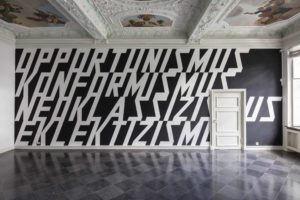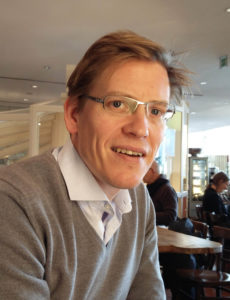 The German artist Lars Breuer is not only painter, but as well curator and teacher. His various activities have also an impact on his artistic work. We questioned him about his experiences and his oeuvre.
The German artist Lars Breuer is not only painter, but as well curator and teacher. His various activities have also an impact on his artistic work. We questioned him about his experiences and his oeuvre.
Astrid Gallinat: In addition to your studies of Fine Arts at the Kunstakademie Düsseldorf you graduated in art history and philosophy at the University in Düsseldorf. Why do you have chosen to add a degree to your practical studies of fine arts?
Lars Breuer: My main focus has always been to work as an artist. Nevertheless, the scientific study is a result of dealing with texts from the beginning. It is important for me to incorporate my work not only formally and spatially, but also in terms of content and history. Scientific texts are often suitable for my work. So, the study of philosophy and art history has come up, because I read the lyrics anyway. But I have to mention that I also consider and use novels and poems equivalently.
A.G.: It is not always obvious but often there are references to art history, philosophy and literature in your works, probably due to your fields of interest. What kind of messages do you want to send out from your artworks? Do you have some examples?
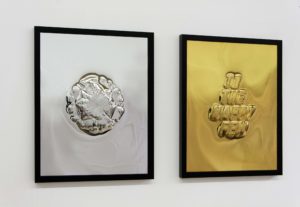 L.B.: My work often arises from the engagement with the space and its use and history. This includes also its story and function. So, when I use my self-designed typography in my works, then I create a semantic reference to these qualities, giving the viewer the chance to make his own individual interpretation according to their interests or knowledge. The place is providing an additional possible interpretation.
L.B.: My work often arises from the engagement with the space and its use and history. This includes also its story and function. So, when I use my self-designed typography in my works, then I create a semantic reference to these qualities, giving the viewer the chance to make his own individual interpretation according to their interests or knowledge. The place is providing an additional possible interpretation.
It is important to me that the terms and words remain visible and legible. On the other hand, the text also changes to an ornamental pattern. The oscillation between semantics and abstraction are important to me. Both qualities do not diminish each other. They rather on the contrary can increase one another like in a complementary contrast. What happens when you combine elements that are not usually brought together, such as Classicist elements of architecture with a futuristic machine of literature? This is an interesting question in which art is not limited to terms or concepts.
A.G.: Since the end of your Fine Arts studies, you were engaged in artist run spaces, first in the Binterimstraße, later with the exhibition space KONSORTIUM both in Düsseldorf. At first glance, this looked like artist self-organisation as in the 1970s. Nevertheless, for years you have curated shows even in external institutions. What was the objective for this activity?
L.B.: My colleagues, Sebastian Freytag and Guido Münch, and I were interested in a cooperation as we shared common interests since the time of the Academy of Arts. The collaboration with other artists arose from the need to provide a platform for an underrepresented kind of art. According to our resources, this initially began as a studio exhibition on a small scale up to major projects such as the exhibition ‘Dystotal’ at the Ludwig Forum in Aachen/Germany (2016) or at the Pori Art Museum in Finland in 2014. We do believe and have always believed that art has to support art.
I think as colleagues we can interact more freely
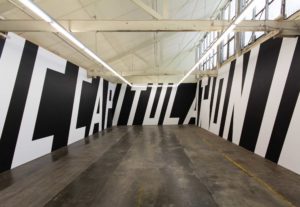 A.G.: What is it like to curate other artists being yourself an artist?
A.G.: What is it like to curate other artists being yourself an artist?
L.B.: I think as colleagues we can interact more freely and in another way. But I have to mention that I only work with artists with the same interests or the same questions. We generally focus on the competition of ideas and solutions.
A.G.: At the same time, KONSORTIUM is an artist collective. What kind of benefits arise from working as group?
L.B.: In the group, we find solutions that I may not find as a solo artist. Maybe I can describe the process as a kind of intersection of three artistic positions. This challenges us to be more precise. On the other hand, the intense exchange helps me to define and strengthen my individual mindset. Guido and Sebastian are among knowing my work best and are usually the first critics.
A.G.: Are there any disadvantages?
L.B.: The joint projects create often an additional intense work, which is not always easy for any of us. But I think that we have found a way to benefit from our controversies productively.
A.G.: Is there a difference if you conceive artworks within the group or just individually?
L.B.: I can clearly affirm this question. The work in the group forces us all to a focus. That produces more rigour. But on the other hand I can use these solutions for my individual work. Working on my own, I just have to give an account for myself. Together we create another essence. This process is interesting for the three of us.
Different formats generate a contrast and tension
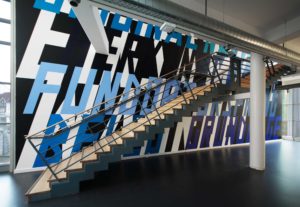 A.G.: Many of your works are words painted in black and white, partly on canvas or directly on walls. How did you develop this type of typography?
A.G.: Many of your works are words painted in black and white, partly on canvas or directly on walls. How did you develop this type of typography?
L.B.: The typeface was developed first out of the need to reconstruct the design on a wall, sometimes confusing because of its size. For this reason, it has no curves and all distances are standardized and spaced equally. This initially makes the font seem awkward. But it creates a quality that allows me to use my typography serially and ornamentally. I like this quality.
A.G.: What do you want to express with the words and quotations or phrases that you use in your works?
L.B.: I use them in different ways. Sometimes I use direct and long quotes; sometimes I create new connections between initially opposed terms. Additionally, I sometimes only use a single word, which I place like a slogan or a catchword. Usually it shows up centrally positioned and looks like a classic logo. This impression is supported by the quality of the typography. First, these individual terms seem to be authoritarian – in their new context they dissolve into an ornamental pattern and their semantic meaning branches out. Terms such as ‘WAHRHEIT’ (truth) or ‘EWIGKEIT’ (eternity) appear to us to be empty and, as paintings in a church, we can at most interpret them as romantic moments of longing.
A.G.: For your self-designed typography, you have chosen only black and white as colours. Why have you chosen these two “non-colours” instead of perhaps more flashy complementary contrasts?
L.B.: Typography usually appears in black and white. Through books and newspapers, we are used to read black letters on white paper. In the first instance, I adopted this conditioning. This also seemed to make sense because black and white is the hardest contrast we can see. Nevertheless I also use coloured letters if this seems reasonable to me due to the circumstances. For example, I worked on several wall paintings with several layers of writing and used different colours for each layer. In addition, the overall situation of an exhibition sometimes requires the use of colour to coordinate the overall composition.
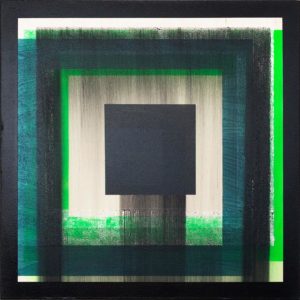 A.G.: The dimensions of your works are very variable: form small size panel paintings to monumental wall paintings. How do you decide the size for one special work?
A.G.: The dimensions of your works are very variable: form small size panel paintings to monumental wall paintings. How do you decide the size for one special work?
L.B.: I do the paintings on canvas in my studio. They are in different formats and in fact, they vary from 30 x 30 cm up to several meters. My criteria are not always explainable. I also work in series with the same format. On the other hand my murals are always inspired by the surrounding architecture. The size of the wall, which I fill from bottom to top and from left to right often defines the format of my work. Or sometimes I connect several walls so that new visual axes and relationships arise in the existing architecture. Whenever I combine a mural with canvas, it is important to me that not only the content, but also the use of different formats generate a contrast and tension in the presentation.
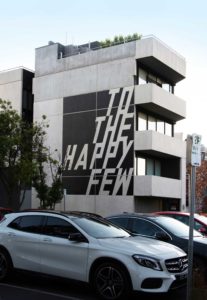 A.G.: A last question: during the last months, you participated in numerous group exhibitions in Germany (Aachen, Berlin, Cologne, Düsseldorf, Witten – with Konsortium) and you had two solo exhibitions in Australia (Melbourne, Sydney). Moreover, this summer your works were on view in a group exhibition in Kiev, Ukraine. When and where is it possible to see your oeuvre in the near future?
A.G.: A last question: during the last months, you participated in numerous group exhibitions in Germany (Aachen, Berlin, Cologne, Düsseldorf, Witten – with Konsortium) and you had two solo exhibitions in Australia (Melbourne, Sydney). Moreover, this summer your works were on view in a group exhibition in Kiev, Ukraine. When and where is it possible to see your oeuvre in the near future?
L.B.: I just installed my work in the project space of the Kewenig Gallery in Berlin. There will be a second group show in Bethanien in Berlin at the end of September. There are plans for two shows in Brazil and France and next year my work will be part of the cultural capital 2020 in Rijeka.
A.G.: Thank you very much for your answers!
L.B.: With pleasure.
Lars Breuer answered via e-mail in German. Translation: Astrid Gallinat & Lars Breuer
Photos © Lars Breuer, courtesy of the artist
Lars Breuer
Born in Aachen, Germany (1974), Lars studied first one year at the Academy of Fine Arts in Münster and then changed to the Academy of Fine Arts in Düsseldorf. Here he graduated as master-class student of Gerhard Merz in 2001. In parallel, he studied art history and philosophy at the Heinrich-Heine-Universität, in the same town and completed with a magister of arts in 2003.
Together with his artist colleagues Sebastian Freytag and Guido Münch, he ran the independent exhibition space “Binterimstrasse 65” from 2002 to 2003. In 2004, the three creatives founded the artist collective KONSORTIUM and moved to their new exhibition space of the same name. At times, Jan Kämmerling was part of the group. Besides their own works, they featured many national and international artists until 2010. Additionally, KONSORTIUM curated external exhibitions in Aachen, Berlin, Düsseldorf, Sydney and Pori (Finland). In parallel, the artist collective showed its group installations in Germany, England, France, Czechia, Lithuania, Poland and Australia.
As individual artist, Lars had numerous group and solo exhibitions in Europe, the United States and Australia. He had several grants, often for traveling. Inter alia, he had residencies in Turkey, Poland and the United States. His works are integrated in various public collections, such as the Ludwig Forum für Internationale Kunst (Aachen), the Museum Folkwang (Essen) and the Justin Art House Museum (Melbourne). Since 2018, he is professor for painting and design, form and colour at the Peter Behrens School of Arts in Düsseldorf.
Lars lives and works in Cologne.

